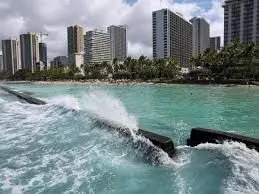Russia Earthquake, Tsunami Update: Massive 8.8 Magnitude Quake Triggers Pacific-Wide Tsunami Alerts
Massive 8.8 earthquake strikes Russia’s Kamchatka, triggers tsunami alerts in Japan, Chile, U.S. coastlines; volcano erupts hours after tremor.
Emergency teams respond after an 8.8-magnitude earthquake strikes Russia’s Kamchatka Peninsula, triggering widespread tsunami alerts across the Pacific.

Early on Wednesday, a strong 8.8-magnitude earthquake that struck Russia's far eastern Kamchatka Peninsula caused tsunami waves as high as 4 meters (13 feet) and prompted evacuation orders in a number of Pacific nations. Petropavlovsk-Kamchatsky, a city of 180,000 people, was 119 kilometers away from the epicenter.
- The governor of Kamchatka, Vladimir Solodov, declared it to be "the strongest earthquake in decades" and confirmed that the vibrations had destroyed a kindergarten.
- Russian authorities said the coastal areas of Kamchatka and Severo-Kurilsk were struck by tsunami waves three to four meters in height.
- A tsunami wave of 30 cm was recorded at Nemuro, Hokkaido, Japan, and warnings were sent out for Alaska, Hawaii, Chile, the Solomon Islands, and New Zealand.
- Following the Pacific-wide tsunami warning, Chile made preparations for possible coastal flooding by raising its tsunami alert to the highest level.
- Additionally, Ecuador anticipated that in some coastal areas, tsunami waves will surpass three meters.
After the earthquake, volcanic eruption
The already shook area was further alarmed when a volcano in Russia's Far East erupted in the hours after the earthquake. Although the eruption was confirmed, Russian geophysical officials have not yet issued a complete risk assessment.
US Officials Say There Is No More Tsunami Risk
“The threat of a major tsunami hitting the U.S. has passed completely,” U.S. Homeland Security Secretary Kristi Noem stated from Santiago, Chile. "We were fully deployed and prepared to respond, but we are glad the worst was avoided," she continued.
Emergency responses remain active across affected areas, and authorities are monitoring seismic activity closely as aftershocks continue across the Pacific Rim.

